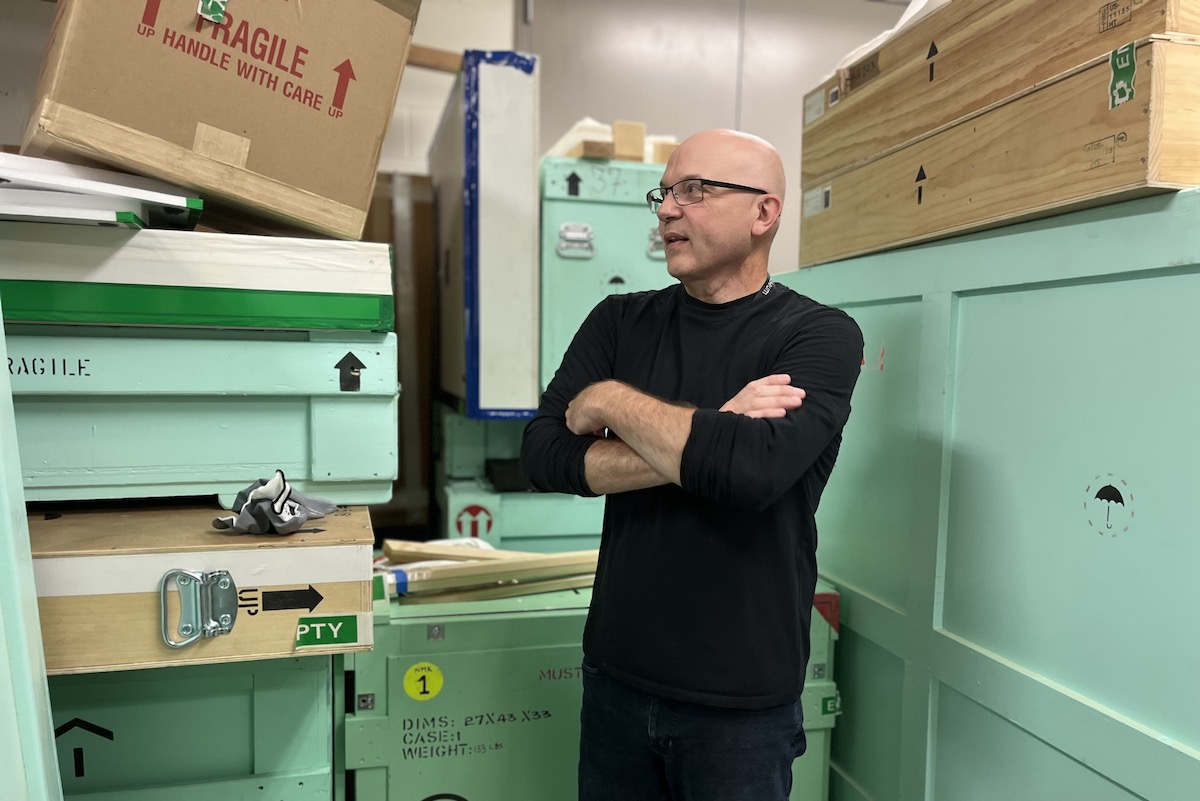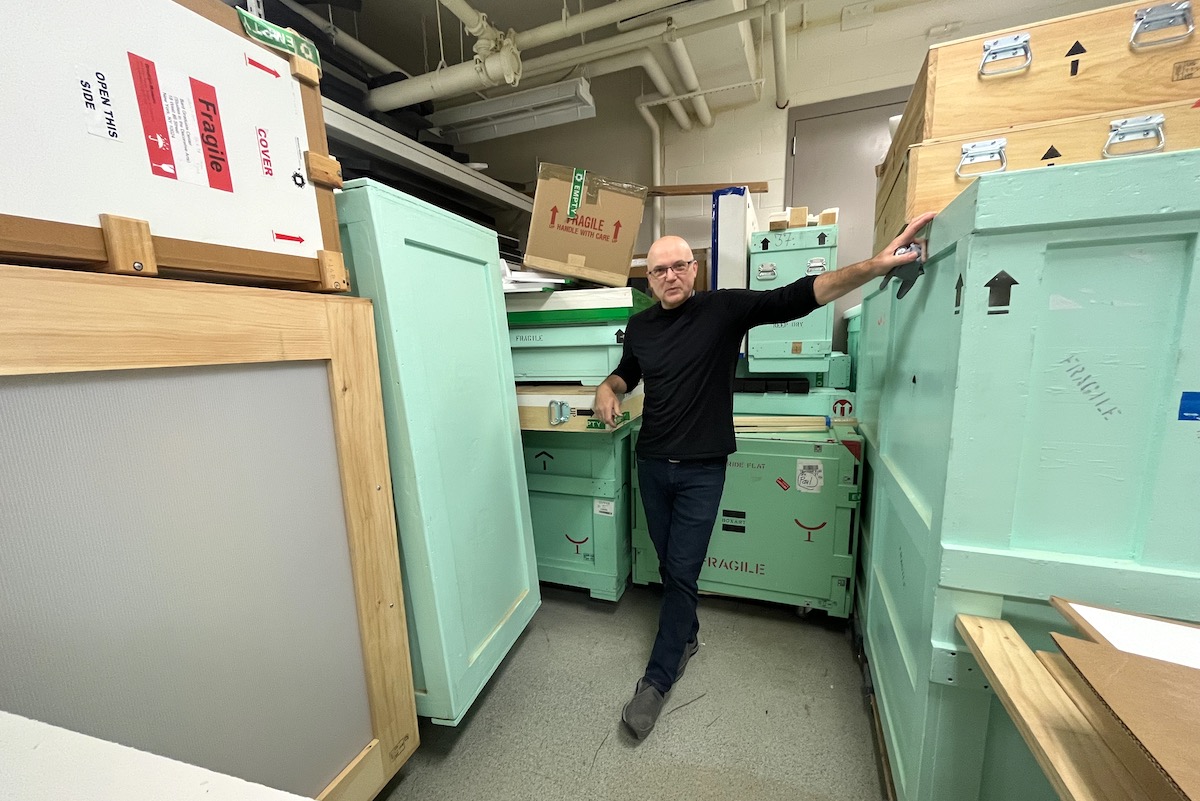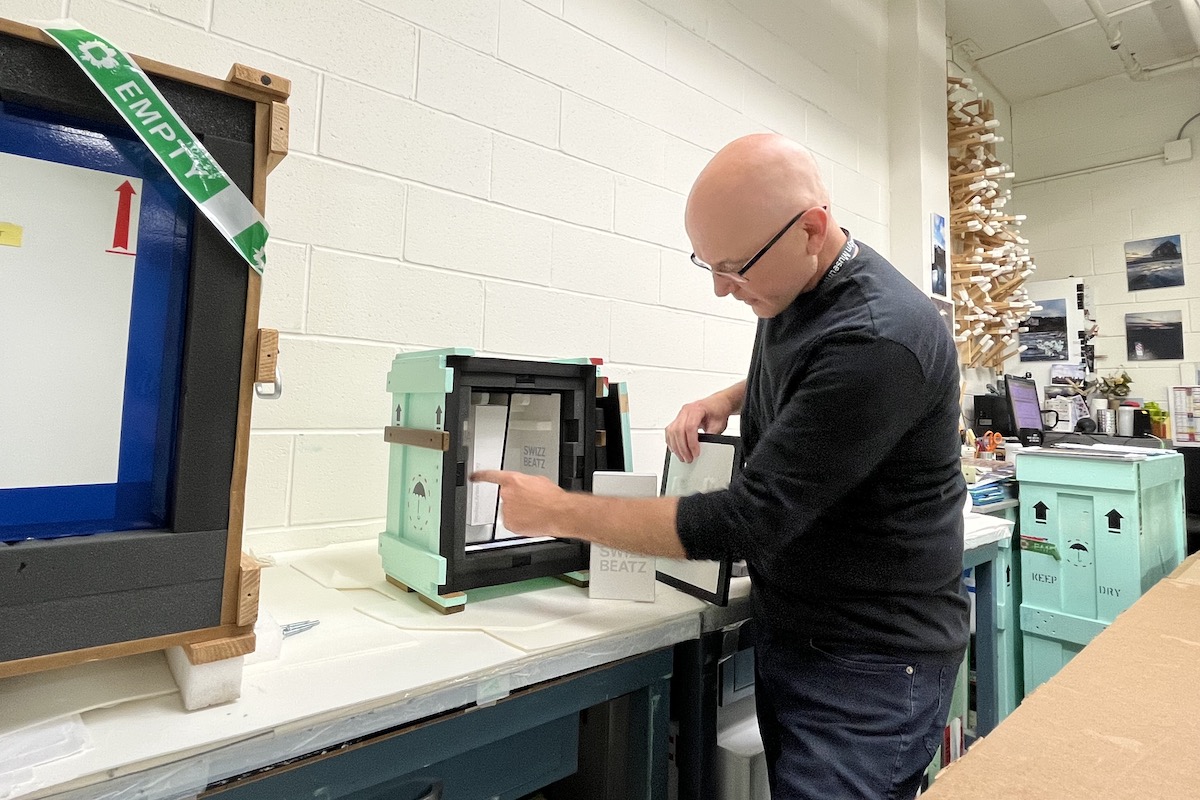
The Intricate, High-Stakes World of Fine Arts Packing
Paul Speh, Fine Arts Packer, walks us through a day in the life of securing art objects for transport.
Every office has its adages: a series of well-worn, time-tested truths familiar to anyone in the business. For Paul Speh, Fine Arts Packer at the Brooklyn Museum, they sound something like this: It’s tough to mail a dinosaur.
You may have follow-up questions; so does everyone. Whenever a stranger asks Speh what he does for a living, he says it prompts an hour-long conversation that becomes more intricately detailed at every level, just like one of his creations.
Speh’s custom-built, intricately detailed crates keep artworks secure as they move between the Brooklyn Museum and viewers all over the world. Whether working with paintings, archaeological finds, textiles, or other mediums, his job is to design and build packages that fit the exact specifications of each object. Having spent decades perfecting the art of close attention, Speh has found that if he spends enough time with artworks, they speak to him—and only by listening can he discover the best ways to keep them safe.
From his office, surrounded by custom tools, materials of every variety, past creations, and crates in progress, Speh spoke about his journey to the Brooklyn Museum and what a fine arts packer does every day.
This interview has been condensed and edited.
Paul Speh: The first piece I ever packed here was Albert Bierstadt’s A Storm in the Rocky Mountains, Mt. Rosalie. It’s a signature piece. That was [in] 2000. The company I worked for had packed it for decades. I had the schematics for it and the Brooklyn Museum asked me to come assess it. I was brand new as the manager of the company. I came back like eight times because I wanted it to fit perfectly. I had been up for 33 hours straight, because another client had had an emergency.
Corinne Segal: What was the emergency?
PS: They had a crate that was to be transported via airplane for which—as often happens—they miscalculated the dimensions. Airlines only allow a certain height—63 inches, which is really 62 3/4 inches—so if it’s beyond that, which this crate was, they need me to come and modify it. I was on their loading dock, modifying the crate for one of their paintings, then had to come straight over here with this ginormous crate. It was myself and a liaison, and every art handler was here, the chief registrar was here, the chief curator was there. I didn’t even pick the piece up; the crate was just there. It was in a travel frame, which is a frame the painting travels inside of. And that was my first job here. It was sort of a surreal experience.
CS: Can you explain in more detail what an art packer does?
PS: I’ll walk you through it. A museum in the world decides that you have a painting that they would like. This painting is a part of a show—let’s say a Picasso show. The curator wants to put together a Picasso show. You have a painting that’s a very important part of their show. So they contact the Museum and they say, “Can we borrow your piece?” It goes through curators and through committees and they decide, “Okay, we agree, it’s a part of your show, it’s important, so we will make a loan agreement.” They make a loan agreement. It goes through Conservation. Conservation says, “We have fees, because we have to clean it, or fix it, or it needs to be framed, or it needs to be packaged,” and so on and so forth.
If that’s agreed upon, then it comes to me. I’ll go and measure the piece, talk to Conservation about it, come back, decide, and design a crate for it and a case interior for it to travel to said place.
 Speh stands with fine art crates at the Brooklyn Museum. (Photo: Corinne Segal)
Speh stands with fine art crates at the Brooklyn Museum. (Photo: Corinne Segal)
CS: What are the kinds of considerations that go into designing a crate?
PS: Paintings are fairly easy, [though] there’s a hierarchy and pieces that can get complex. The biggest consideration is vibration mitigation and damage control. The considerations go as far as the exterior of a crate. Every museum has their own crate color for a reason. You dress for the party, right? It has to show up a certain way; you paint the crate so it gets handled a certain way. If it doesn’t get handled that certain way, the damage will show up right away. It’s for permanence, for the outside, for identification, and it’s to show care. Something that is perfectly painted gets handled a lot better than something that isn’t. That’s the number-one consideration for the exterior, and anybody can make an exterior.
The interior is really where we shine in Brooklyn. Our interiors are better than most interiors you see.
If you have a painting that goes into a crate and it’s heavy, it’s going to migrate a little. So you acclimate for that migration. I call this process—of letting an object settle—“cooking.” Cooking is when you allow the piece to settle into the crate cushioning naturally with time and gravity. Usually it takes a few days. The painting will migrate to where it’s supposed to be. And once it’s finally settled, I will fit the top so it fits ever so perfectly. So when that piece comes out of that crate, it actually makes an audible shwoop. It slides in so perfectly.
CS: How long does it take to “cook”?
PS: I usually do it over a weekend, sometimes a little longer. It could be a day or two, depending on the frame. If the frame is a knife edge, it’s a little longer of a cook, and then you make adjustments.
It’s built like a house. If you were to build a home for a piece of artwork, it’d be exactly the same way. It has an exterior, it has a vapor barrier, it has a gasket barrier, and then it has the insulation/migration barrier, and another vibration barrier, and another cover and another box. And that’s just for a painting.
“Artwork speaks to you, regardless of what culture it comes from or where it comes from. All of it. You just have to listen.”
CS: How did you start in this profession?
PS: I graduated from Cranbrook Academy of Art in Michigan. At the time, it was the number-two school in the country. I thought I was going to be a professor, and that didn’t happen. There were only eight people in my discipline who graduated, and there were three people who became professors, and it just didn’t happen for me. So I had to pivot. I didn’t want to give up on my art career or my love of it. I went to several places. One of them was a picture frame company here in New York. They make some of the most fantastic frames. It was close, but it wasn’t right. I ended up answering an ad in the paper that said, “Learn fine art crates.” So I said, “All right, I’ll try it; it’s been six months I’ve been looking, so I’ll answer the ad.”
So I went to the place. It looked awful. It looked awful! You walked in and it was a mess. There were papers everywhere. It was plain-Jane. I’m in a suit and tie. The interviewer was terrible. And I was like, “All right, just give it some time. Just try to figure out what they do here, because you can’t really tell.”
I was in the main office, so I just started listening. And I heard one woman say to another woman, “Are we going to pick up those de Koonings next week?” And I went, “Oh my goodness, she just said ‘de Kooning.’ This is a real place. This is a REAL real place. Willem de Kooning.”
I don’t know what the interviewer was saying [at that point]. I said, “Excuse me. Do you have examples of what you do here?” He said, “Let me go get the book.” So he comes back with a book. He flips open the book and the first thing that’s in the book are these Brâncușis. And one wonderful thing after another, after another.
I got the job. I actually built the crates for those de Koonings. And I took it from there.
CS: What are some of the more difficult items to pack from a technical standpoint?
PS: Dinosaurs. Dinosaurs are difficult.
CS: Tell me about packing dinosaurs.
PS: So the hierarchy of things goes: dinosaurs, mummies, neon, unfired ceramics, and pastels—believe it or not, they’re very difficult.
Then you have size, and size becomes more difficult. I’ve packed Roy Lichtenstein Brushstrokes, which is 60 feet tall. The crate [needed] a double-drop tractor trailer; the crane picks it up to spin it sideways and then bring it down.
 Close-up of materials in Speh’s office at the Brooklyn Museum. (Photo: Corinne Segal)
Close-up of materials in Speh’s office at the Brooklyn Museum. (Photo: Corinne Segal)
CS: What is it like to pack items with a certain cultural context surrounding them, such as during repatriations?
PS: I can talk about one piece, a dance skirt belonging to the Wiyot Tribe.
I got an email from [Mellon Senior Curator of Arts of the Americas] Nancy Rosoff about working on a repatriation. This was a complex piece. It’s a sacred ceremonial dance skirt that has abalone shells attached to it. It’s one single piece of rawhide. It’s about four foot by four foot. I think it’s over 100 years old. It’s in fairly good condition. It’s been conserved by Conservation.
When you meet with Conservation, they tell you the constraints of it: “We have this skirt, but it has to be hand-carried.” A hand-carry is quite different from a crate. They’re going to come actually pick these pieces up, so you have to design something for a person to actually pick up. Now, a four-foot-by-four-foot skirt is not an easy thing to just pick up. It’s about twenty to thirty pounds.
Also, only females are allowed to handle that skirt. So now, not only do I have to pack it, I have to pack it strategically so that I never touch it. You can move it, but you can’t physically touch it. So I had to come up with my own constraints. And that’s typical—you figure out how to do it.
Then, the skirt had to fold perfectly in half and go into a case that had two covers that had braces that held the shells from moving, and then a top that would cap it, and then a shoulder strap to put around the outside of the crate—and then I had to research airplanes, which ones it could even go into.
After all that research, designing, and creative processes, in the end, due to pandemic concerns, the decision was made to ship it instead.
It was a great project to work on and I gained so very much from the entire process. The end result, on [people’s] faces when they received it, just lights you up. You see it has returned back to where it’s supposed to be.
This nation still makes the same skirts today. So I said, “I need to hear what this sounds like. I can’t touch it, I can’t move it, but I hope it exists somewhere out there on the Internet.” So I went and I researched it, and I found a video on YouTube. As I was packing it, I wanted the skirt to hear itself.
CS: How did you pack it without touching it? Did you work with female assistants?
PS: Some assistants, and then you make your own armatures, prosthetics to keep yourself detached from the item physically. They understand that you’re going to move it, so you just be as respectful as you can.
 Speh stands alongside one of the crates he built for the Brooklyn Museum. (Photo: Corinne Segal)
Speh stands alongside one of the crates he built for the Brooklyn Museum. (Photo: Corinne Segal)
CS: When you are handling other objects that are culturally sensitive, what is your process like? What considerations come up?
PS: Artwork speaks to you, regardless of what culture it comes from or where it comes from. All of it. You just have to listen. So you walk up to a piece and it tells you what it wants or needs, all the time, constantly: “[Here’s] where to go with me, how to hold me, how to care for me.” If it’s speaking to you in a more soulful sense, you have to listen to that as well, and then you just go to where it leads you.
I am so very grateful and honored to have these interactions with pieces that no one else gets to have.
CS: I have one last question. Are you good at craft projects?
PS: Yeah, I’m superior.
Corinne Segal is Senior Manager of Web Content at the Brooklyn Museum.